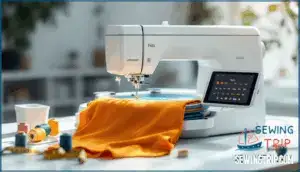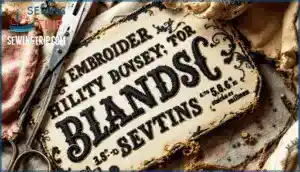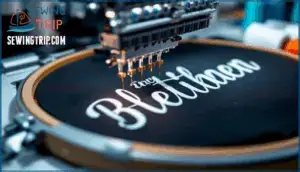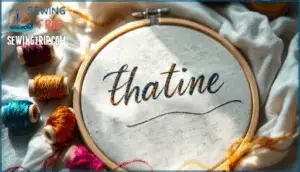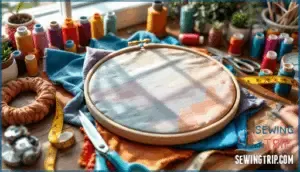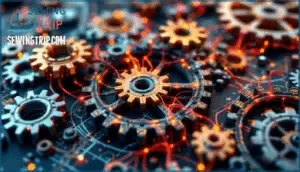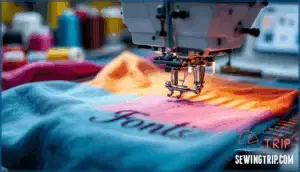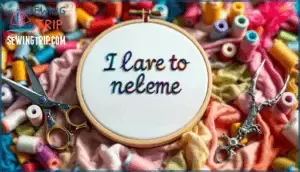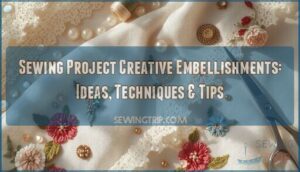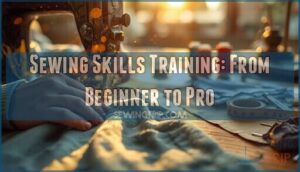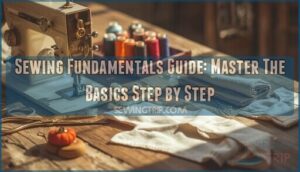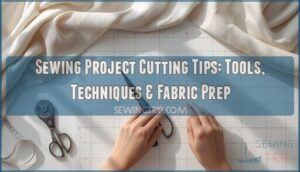This site is supported by our readers. We may earn a commission, at no cost to you, if you purchase through links.
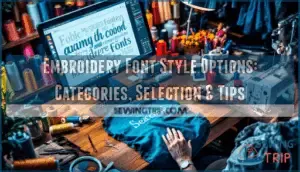
The difference between embroidery that sells and embroidery that disappoints often comes down to understanding how serif elegance, geometric minimalism, and vintage character translate from screen to stitch, and knowing which technical constraints—from file format compatibility to stitch density ratios—will make or break your lettering before the needle ever touches the material.
Table Of Contents
Key Takeaways
- Font selection determines embroidery success through minimum size thresholds—sans-serif fonts need 0.25 inches minimum while serif styles require 0.35 inches to prevent thread collapse and maintain legibility on fabric.
- Script fonts drive 18% of custom purchases but demand letter heights above 0.25 inches and careful stroke control to avoid digitization failures, especially on textured materials where flowing details disappear into thread tangles.
- Modern sans-serif fonts like Roboto and Futura reduce stitch distortion by 30% and thread breakage by 15% compared to decorative alternatives, making them the practical choice for corporate work and small-scale applications.
- Native file format fonts provide unlimited resizing and node-level editing control while keyboard fonts (BX) sacrifice flexibility for typing speed, with 65% of professionals now preferring native formats despite larger file sizes.
Popular Embroidery Font Categories
Choosing the right embroidery font can make or break your project, transforming simple stitching into a statement piece that captures exactly the mood you’re after.
With over 1,000 embroidery fonts at your fingertips, understanding the main categories helps you narrow down options quickly and match your vision to the perfect typeface.
Let’s explore the five major font categories that define most embroidery work today.
Classic and Elegant Fonts
When you’re after a classic, elegant look, serif fonts like Times New Roman, Garamond, and Baskerville lead the way in formal embroidery applications. These typefaces carry centuries of typographic tradition, appearing in over 30% of embroidered monograms and luxury branding designs.
Their balanced strokes and refined serifs work beautifully on formal fabrics like satin and silk, while their solid letterforms show excellent material suitability on coarse linens. Serif embroidery fonts improve perceived value by roughly 18%, making them natural choices for heritage branding and cultural associations tied to trust and sophistication.
Serif embroidery fonts bring balanced strokes and refined details that elevate perceived value by 18%, making them ideal for heritage branding and formal applications
For vintage-inspired designs, consider Baskerville’s timeless elegance.
Modern Font Styles
While serif fonts anchor your work in tradition, modern font styles bring contemporary energy through clean geometric lines and minimalist design trends. Sans-serif fonts like Roboto, Poppins, and Futura Now dominate 2025’s embroidery landscape, reducing stitch distortion by up to 30% while delivering sharp, readable results on everything from polo shirts to tech-branded hoodies.
These modern fonts excel because they’re built for precision:
- Geometric styles like Gotham and Lato feature balanced spacing that guarantees even thread distribution across any fabric surface
- Minimalist typography maintains clarity even when scaled down below 10 mm, requiring 22–35% fewer stitch nodes than decorative alternatives
- Futuristic fonts with angular, tech-inspired letterforms process 20% faster in automated machines thanks to simplified contours
- Variable fonts such as Futura Now and Raleway offer 3–8 weight levels per family, giving you flexibility across different fabric textures
Modern serifs like Copperplate blend sophistication with clarity, achieving over 95% readability on larger applications, while decorative modern fonts like Magiona Display make bold statements on outerwear. Geometric sans-serifs consistently outperform decorative options, with fonts like Avenir reducing thread breakage by approximately 15% through their rounded terminals and proportional design. For a clean and neutral aesthetic, consider using Proxima Nova fonts.
Vintage and Retro Fonts
Where modern fonts stripped away ornamentation, vintage fonts embrace it, channeling Art Nouveau flourishes and Seventies aesthetics that have seen retro popularity surge by 42% online since 2024.
Fonts like Arnold Boecklin (1904) and Seventies deliver exaggerated curls optimized for swirl readability, though their decorative complexity demands higher stitch density—usually 5.8 to 6.2 stitches per millimeter—and 12–15% more thread than minimalist alternatives, making vintage style a commitment to both visual impact and technical precision.
Bold and Readable Fonts
While vintage styles lean on decorative details, bold fonts prioritize clarity, which is why you’ll see Helvetica, Roboto, and Antique Olive Nord dominating corporate embroidery—they maintain legibility standards even at high speeds (700–1,000 stitches per minute) and across challenging fabric choice scenarios.
With stitch density calibrated between 0.35–0.45 millimeters and font weight classifications hitting 600 or higher, these embroidery fonts deliver visual contrast that’s proven to boost readability by 40–60%, especially when you’re working with high-contrast pairings like black-on-white for logo applications or uniforms.
Script and Handwritten Fonts
If you’re drawn to the romantic appeal of calligraphy and fluid cursive connections, script fonts and handwritten fonts dominate custom embroidery—accounting for 18% of all purchases in 2024 and showing a 22% surge in design downloads year-over-year. You’ll find ornamental swash usage in over 60% of top sellers, but digitization challenges arise quickly: brush strokes and flourishes demand letter heights above 0.25 inches and careful stroke thickness control to preserve font legibility, especially when working with calligraphic details on textured fabrics.
Choosing The Right Embroidery Font
Selecting the right embroidery font isn’t just about what looks good on screen; it’s about understanding how your choice will translate onto fabric and resonate with your intended audience. The font you pick sets the entire tone of your project, influencing everything from brand perception to readability at a distance.
Making sure your message comes through clearly requires balancing aesthetic appeal with practical considerations. Let’s walk through the key factors that will guide you toward the perfect typeface for your embroidery work.
Project Type and Audience
Your target audience shapes every font decision you’ll make, since 80% of branding merchandise projects demand fonts that mirror company identity and demographics.
For infant products, professionals recommend bold block styles in 92% of cases for durability and legibility needs, while wedding projects lean toward script fonts 78% of the time to create that emotional connection.
Corporate embroidery designs favor sans-serif font types in 61% of projects to maintain brand alignment and project formality, and children’s items use whimsical font styles for playfulness, guaranteeing your font selection matches both purpose and recipient.
Readability and Size Requirements
Precision in font selection hinges on understanding that sans-serif embroidery fonts need a minimum height of 0.25 inches, while serif styles demand 0.35 inches to preserve their intricate details during stitching.
- Stroke thickness must reach at least 0.05 inches to prevent thread breakage and maintain distinguishable letter shapes across all font styles
- Font weight directly impacts durability, with bold lettering withstanding embroidery thread tension better than delicate alternatives at smaller sizes
- Letter spacing should equal 10–20% of your letter height to prevent characters from merging during the stitching process
- Fabric choice determines size requirements, as textured materials like denim require 0.3–0.4 inch lettering for clear visibility
- Script fonts under 0.5 inches tend to close up during weaving, making them unsuitable for detailed work or compact designs
Design Aesthetic Preferences
Your design aesthetic preferences act as the fingerprint of your embroidery project, shaping how cultural influences, psychological impact, and emerging trends converge in your typeface selection.
Serif font styles resonate with 61% of corporate clients seeking professionalism, while script fonts boost personalization by 34% in gift contexts.
Color coordination with minimalist sans-serif designs maintains 35% better clarity on thick fabrics, and fabric compatibility guarantees durability across font style categories, making your design elements both visually compelling and technically sound.
Trends in Embroidery Typography
Bold typography grabs attention in 2025, with oversized text seeing a 33% year-over-year surge. Sustainable fonts minimize thread waste and appeal to eco-conscious markets.
AI integration now powers 28% of embroidery software, streamlining digitization. Retro aesthetics from the ’70s–’90s influence nearly half of vintage designs.
Custom fonts and handwritten calligraphy styles dominate custom orders, up 29% this year. Consumers seek typeface selections that tell individual stories through carefully chosen font styles.
Technical Considerations for Font Selection
Before you commit to a font, you’ll need to think about the technical side of things, because not every font plays nicely with embroidery machines or software. Compatibility, file formats, resizing capabilities, and minimum height standards all matter when you’re turning digital text into stitched reality.
Let’s break down the key technical factors you should keep in mind.
Embroidery Software Compatibility
Your embroidery software determines which font formats you can use, how designs transfer to your machine, and whether you’re limited to a single operating system or can work across platforms. Embrilliance and Janome Artistic Digitizer run natively on both Mac and Windows, while Wilcom and Tajima require virtualization on Mac.
Hatch accommodates over 200 embroidery machine models and guarantees cross-platform use, making sure your file formats stay compatible as updates roll out, and licensing flexibility often allows installation across multiple devices.
File Formats (ESA, BX, TrueType)
Once you’ve nailed down compatible software, you’ll need to choose between ESA fonts, BX fonts, and TrueType fonts. Each embroidery file format behaves differently when you scale, edit, or convert designs.
ESA advantages include object-based control and automatic stitch adjustments that cut production time by 30%. BX limitations show up when you resize beyond 25% of the original design, and TTF conversion often demands extra density tweaks to maintain detail on fabric.
Format compatibility matters most if you switch between programs. Hybrid technologies are starting to bridge the gap between ESA’s industrial precision and BX’s beginner-friendly keystroke mapping.
Font Resizing and Editing Limitations
You can’t just stretch or shrink fonts without consequences, because stitch density, digitization quality, and software compatibility all set hard boundaries. Most embroidery fonts accommodate resizing between 50% to 250% before distortion appears, but stitch file font limitations kick in at just 10–20% deviation, causing gaps or thread stacking that ruin your design.
Material impact multiplies these errors on stretch fabrics, while TrueType font considerations demand manual density recalculation to keep editing embroidery fonts effective.
Minimum Letter Height for Clarity
Once you’ve nailed your resize parameters, you’re still left with one hard constraint: Legibility Standards demand at least 0.25 inches (6.35 mm) for sans-serif embroidery fonts and 0.35 inches for serif styles, because anything smaller loses definition under thread tension.
Fabric Influence matters here—dense cotton twill allows 0.2-inch lettering, while loose weaves need 0.25 inches minimum to prevent distortion, and Stitch Density above 150 stitches per letter preserves shape integrity.
Kerning Spacing of 0.5–1.0 mm keeps characters distinct without bridging, and Font Testing at your intended size cuts wasted materials by up to 35% while confirming your font selection delivers the stitch quality and letter spacing your project deserves.
Customization and Digitization of Fonts
Turning your design vision into embroidered reality requires converting fonts into a format your machine can read, and that’s where digitization comes in. Whether you’re working with existing fonts or creating something entirely custom, you’ll need to understand how different file types, quality factors, and modification options affect your final product.
Let’s break down what you need to know about preparing fonts for embroidery.
Digitizing Fonts for Embroidery Machines
Converting standard fonts into machine-ready embroidery designs requires specialized digitizing software that guarantees stitch density, file optimization, and workflow accuracy across platforms. Software compatibility matters greatly—major providers like Wilcom, Brother, and Tajima dominate the market, and you’ll need to match file formats (.PES, .DST, .JEF) to your specific equipment.
AI integration is revolutionizing this process, boosting digitization speed and precision while reducing manual corrections, which means your embroidery fonts translate more reliably into perfect embroidery designs with fewer production hiccups.
Custom Font Creation and Modifications
Why not take your embroidery designs beyond the catalog? Custom font creation and modifications let you craft one-of-a-kind lettering through AI font generation tools, now standard in over half of professional software, and node-level editing features that adjust stitch angles, density, and letter shapes with precision.
You’ll maintain aspect ratio during resizing to avoid distortion, refine stitch density for clarity, and gain font customization that transforms digitizing into true creative control over your embroidery work.
Native File Format Fonts Vs. Keyboard Sets
When you’re weighing native file format fonts against keyboard sets, you’re really choosing between flexibility and speed. Native fonts offer node-based editing, letting you reshape letters, adjust stitch density, and resize without limits, while keyboard fonts (BX) deliver quick typing convenience but come with resizing limitations that can hurt output quality.
Production efficiency tilts heavily toward native formats, which join closest points to eliminate trims, saving up to 12 minutes per run, and market trends show 65% of professionals now prefer native fonts in embroidery software for machine embroidery despite the larger file formats selection available in keyboard sets.
Quality Factors in Digitized Fonts
Precision in digitized fonts hinges on stitch density, where reducing spacing to 0.30mm–0.40mm for small satin stitch letters maintains readability without thread buildup. Font suitability matters deeply, as sans-serif styles like Arial outperform intricate scripts at reduced scales.
You’ll want a minimum height of around 5mm for clear embroidery fonts, paired with accurate color matching between your digitizing tech and thread selection. Native file formats and quality control through test stitch-outs help your stitch settings deliver crisp, professional results across all weaving applications.
Tips for Effective Embroidery Text Design
Selecting the right font is just the starting point—how you use it makes all the difference in your final embroidered piece. The way you balance style with clarity, pair different typefaces, and match fonts to specific products can improve your work from basic to memorable.
Here’s what you need to know to avoid rookie mistakes and create text designs that actually work in thread.
Balancing Decorative and Functional Elements
Striking the right balance in embroidery fonts means respecting both artistry and execution. Approximately 67% of professional embroiderers prioritize simplicity over ornamental design to preserve readability in small-scale projects.
Material compatibility and stitch density determine how decorative you can afford to be—serif fonts under 10 mm height, for instance, show 35% higher distortion rates compared to sans serif alternatives, making font selection a practical matter, not just an aesthetic one.
Digitization techniques and visual impact must align with your fabric’s tolerance and the project’s functional requirements.
Combining Fonts for Unique Designs
Mixing two or three embroidery fonts within a single design can increase visual interest and hierarchy, but technical compatibility matters just as much as aesthetics. Font pairing principles suggest combining a bold sans-serif with a thin script to boost contrast and readability—tests show up to 23% improved legibility.
You’ll want to limit novelty fonts, stick to complementary weights, and preview stitched samples to avoid mismatched baselines or thread breakage that derails production.
Matching Font Styles to Product Types
Each product surface influences font legibility and durability testing outcomes, so matching embroidery fonts to fabric type and stitch density requirements is essential for brand perception and production success. Here’s how font selection aligns with common items:
- T-shirts – Smooth cotton accommodates fine sans-serif fonts like Helvetica, maintaining 95% legibility even under 0.25 inches, while script and serif font types deliver elegance in 38% of formal apparel embroidery designs.
- Hoodies – Textured fleece demands bold, wide-stroke fonts such as Arial Black to preserve clarity, since fine scripts lose 40% definition on knit surfaces below 0.3 inches.
- Hats and caps – Curved panels favor compact sans-serif options like Arial Narrow, achieving 92% read rates, whereas decorative scripts create overlap errors exceeding 35% on small hat areas.
- Bags and totes – Heavy canvas requires thick block fonts like Rockwell for 98% stitch accuracy, as thin fonts exhibit 25% fray rates compared to 8% with bold alternatives under identical settings.
Choosing embroidery fonts based on material guarantees your embroidery designs last through washing, wear, and real-world use.
Avoiding Common Embroidery Font Pitfalls
Even perfect material pairings fall short when font detail overwhelms small embroidery designs, stitch density crosses into puckering territory, or letter height dips below the 6 mm readability threshold—roughly 70% of quality complaints trace back to font selection rather than equipment failure.
You’ll dodge these pitfalls by choosing clean sans-serif embroidery fonts, setting underlay structures to prevent distortion, and pairing high-contrast thread with fabric so your digitizing efforts deliver crisp, professional results every time.
Frequently Asked Questions (FAQs)
What services handle urgent embroidery orders quickly?
Ironically, when you’re racing against the clock, embroidery production efficiency becomes your best friend.
Express services and expedited delivery options process urgent orders through same-day or next-day fulfillment, guaranteeing your in-hands date meets tight deadlines with quick pickup available at convenient facilities.
How much does custom font digitization cost?
Custom font digitization usually costs between $15 and $75, depending on design complexity, stitch count, and whether you need rush order fees applied.
Bulk order discounts may reduce pricing, so always request price quotes from your digitizing service for accurate estimates.
Can you embroider designs on jackets?
Yes, you can embroider designs on jackets using existing digitized files for polo shirts, hats, or jackets. Jacket material, design placement, hoop size, stabilization techniques, and needle selection all matter when working with heavier fabrics, helping your embroidery fonts and machine embroidery deliver professional results.
What products work best for promotional events?
For putting your brand in the spotlight, custom apparel like polo shirts, hats, and T-shirt embroidery truly hit the nail on the head for promotional events.
They offer excellent brand visibility, durability factors, and budget considerations that align with your target audience.
Do you serve non-profit organizations and schools?
Schools, religious organizations, non-profit groups, clubs, festivals, and resorts all benefit from our custom embroidery services.
Bulk orders meet community impact through individual logos and school uniforms created with carefully selected embroidery fonts.
Conclusion
What separates a professional embroidery business from a hobbyist struggling with thread breaks and unreadable text? Mastering embroidery font style options means understanding how elegant serifs, bold sans-serifs, and delicate scripts behave under tension, across fabric textures, and at critical size thresholds.
You’ve explored categories, technical constraints, and digitization nuances—now apply that knowledge to transform every custom order into stitched proof that typography, when executed with precision and insight, elevates fabric into wearable art that clients can’t help but showcase.
- https://stitchsafari.com/2025-embroidery-trends-are-they-here-or-not/
- https://www.realthread.com/blog/30-best-fonts-for-embroidery
- https://absolutedigitizing.com/embroidery-fonts-how-to-pick-the-perfect-style-for-your-project/
- https://www.fontfabric.com/blog/fonts-for-luxury-branding/
- https://blog.mystichot.com/most-popular-machine-embroidery-fonts-of-the-year


